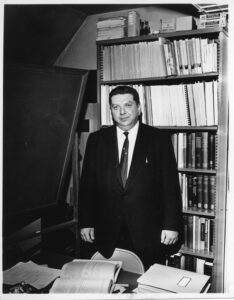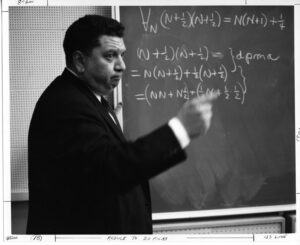
Born in 1925 in Brooklyn, New York, Max Beberman was a pioneer of New Mathematics known for his engaging and active teaching style. After receiving his B.A. in mathematics from the City College of New York, Beberman served in the United States Military until 1946. Upon discharge, he began to teach mathematics and science in Alaska before returning to school to earn his M.A. from Rutgers University and a Ph.D. in mathematics education from Columbia.
While he endeavored to complete his own education, Beberman began instructing at the University of Illinois in 1950. Beberman worked tirelessly to advance the field of mathematics and educate his students until his untimely death in 1971. His teaching style was magnetic; it was said that he could “teach mathematics to a stone wall.” Beberman was a master at “discovery learning,” in which students are provided abstract information and gently prodded to make their own conclusions.
Perhaps more well-known than Beberman’s personal teaching acumen were the significant changes in school math curriculums he advocated. In the early 1950’s, the College of Engineering noticed a severe drop-off in the baseline mathematics knowledge possessed by incoming students. As a result, the University of Illinois Committee on School Mathematics (UICSM) formed in an effort to reform and improve math curriculum at all levels of education.
As a leading member of the committee, Beberman helped push for sweeping changes in approaches to teaching math. He preferred to think of math as a language with rules and logic to follow towards conclusions, not simply something to memorize. Beberman pushed for an emphasis on the why of mathematics, instead of the how.
While initially met with general support, New Math also faced significant criticism. Many school districts were resistant to make the changes in thinking and curriculum necessary to embrace New Math. Teachers would have to change much of their style in order to fit the new standards, and parents were concerned that their children would have a hard time adapting to this drastic tone change.
Higher level scientists, such as Richard Feynman, noted how New Math could focus too much on high level math at the expense of the basics. This mixed reception led to the end of New Math curriculum developments, but many of its ideas continue to influence education planning today.

Beberman would not get to continue advocating for his mathematical approach. His long hours and poor health habits had taken a toll on him, and he had put much strain on his heart. He received a heart valve replacement in 1965, but it wasn’t enough. He succumbed to complications due to a failure of the valve on January 24, 1971 at the age of 45.
While Beberman’s full vision of math education would never be realized, his skill as an educator and fresh outlook on learning would create a long-lasting and impactful legacy, and his ideas continue to affect mathematics education to this day.
- Altgeld Hall – the current location of the Mathematics Department.
Max Beberman is Dead at 45; A Creator of New Mathematics. (1971, January 26). Retrieved from https://www.nytimes.com/1971/01/26/archives/dr-max-bebermanls-dead-at-45-a-creator-of-new-mathematics.html.
Miller, J. W. (1990). Whatever Happened to New Math? American Heritage, 41(8). https://www.americanheritage.com/whatever-happened-new-math-0.
Raimi, R.A. (2004, May 6). Max Beberman. University of Rochester. https://web.math.rochester.edu/people/faculty/rarm/beberman.html.
